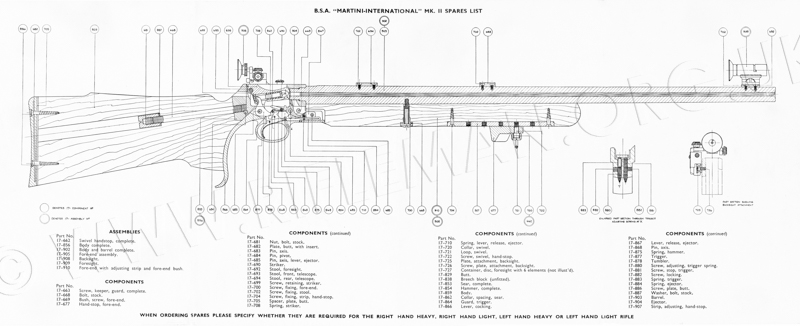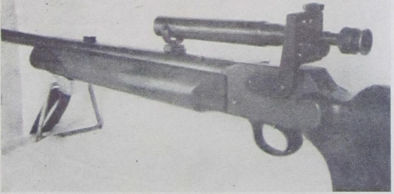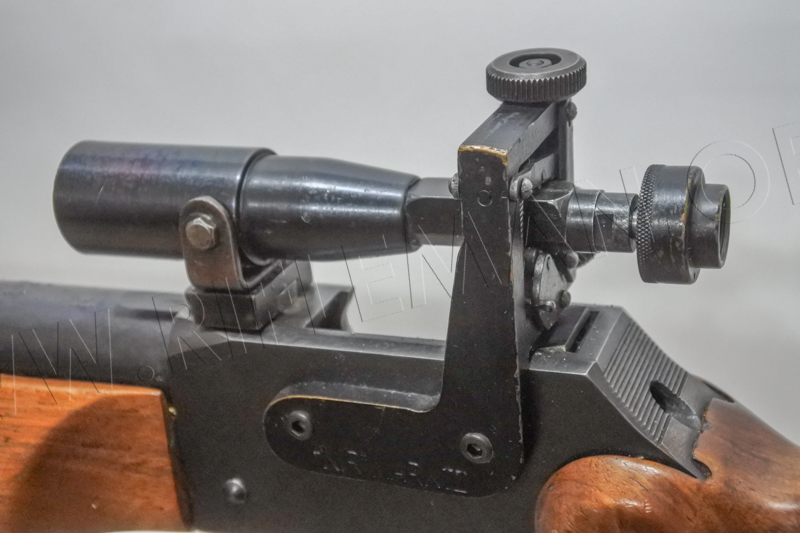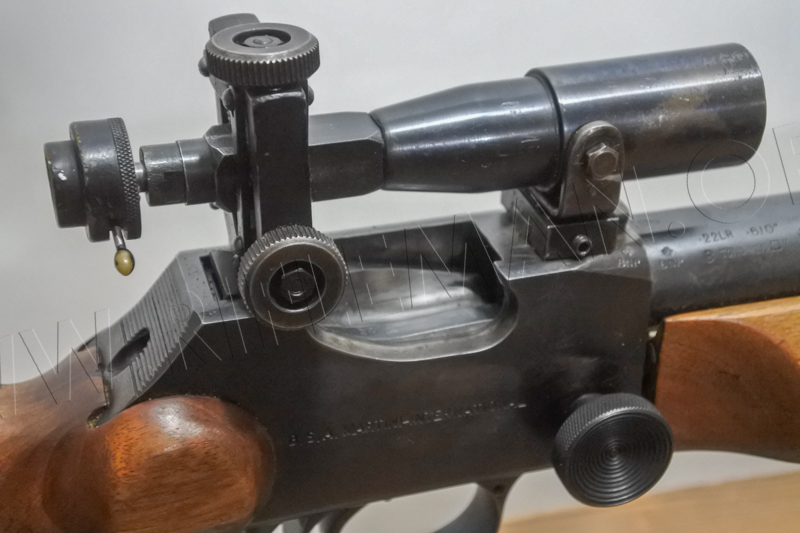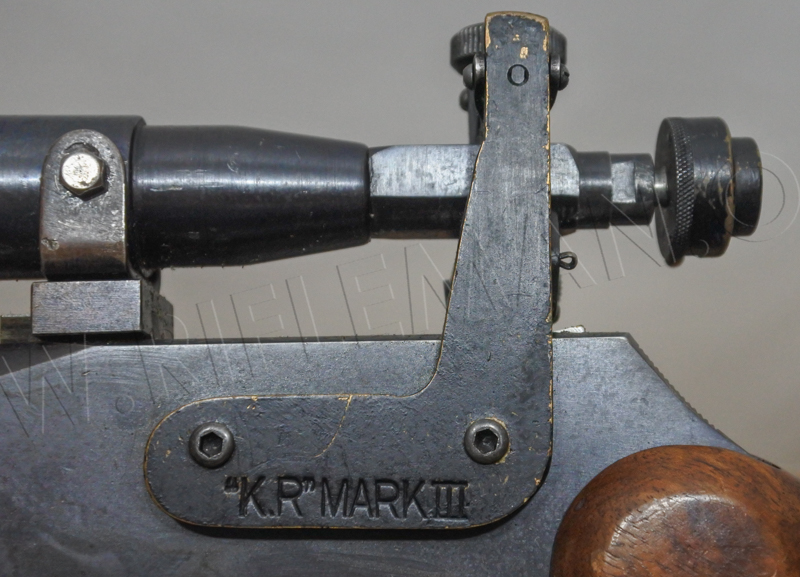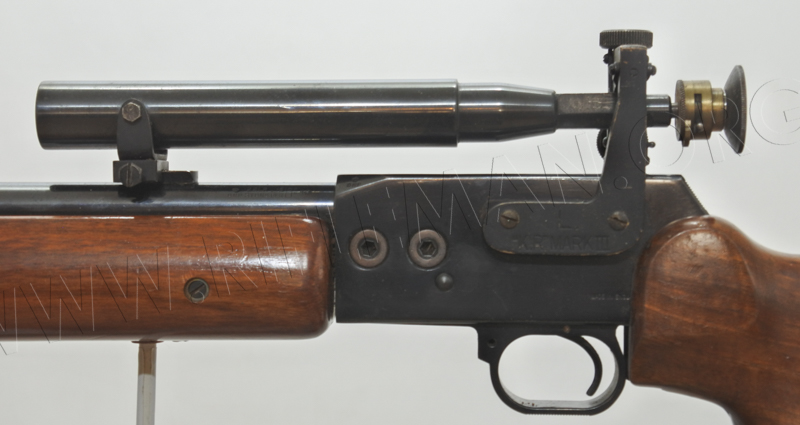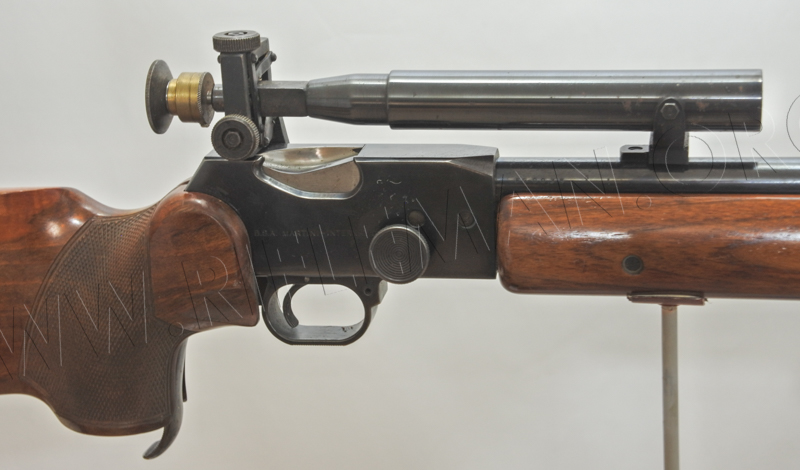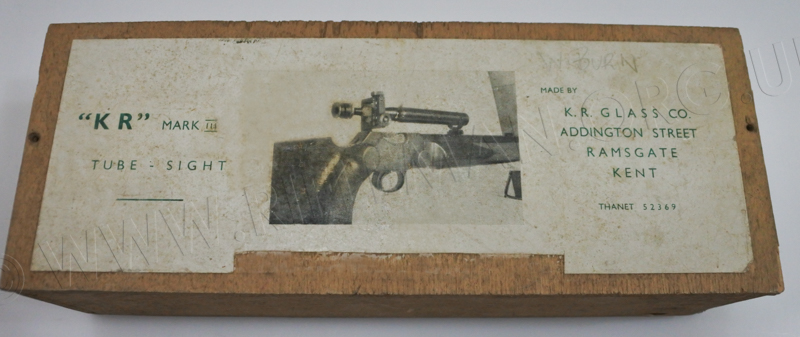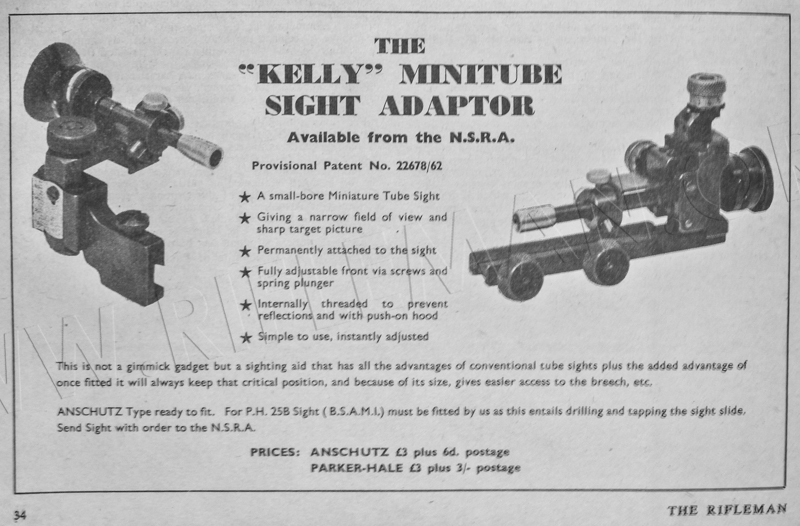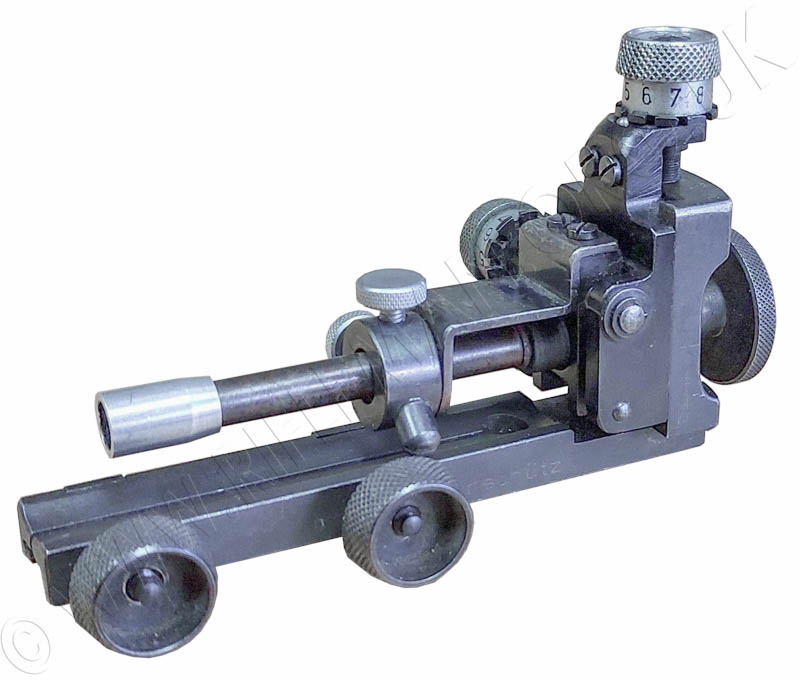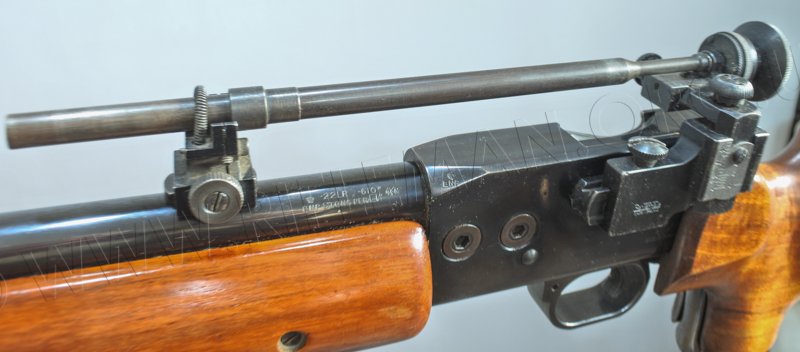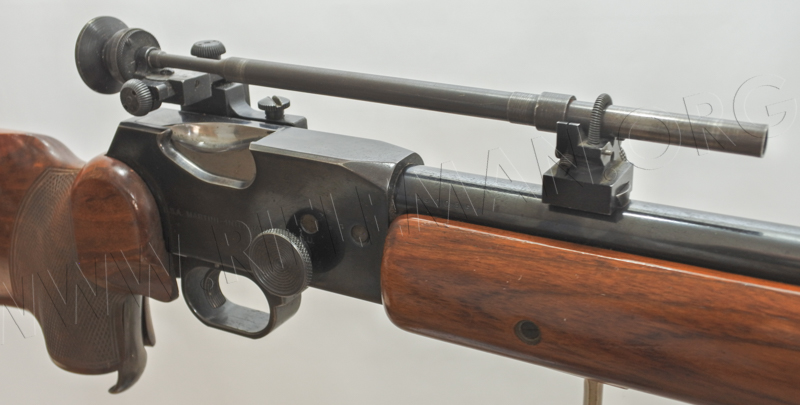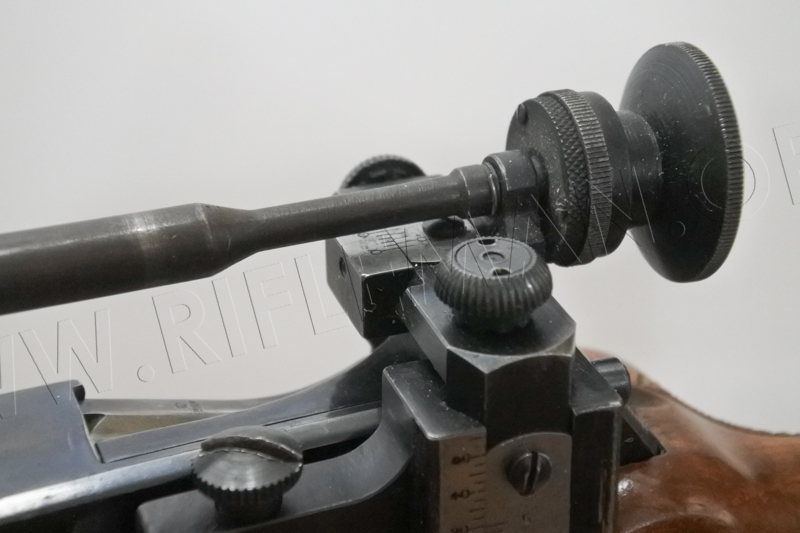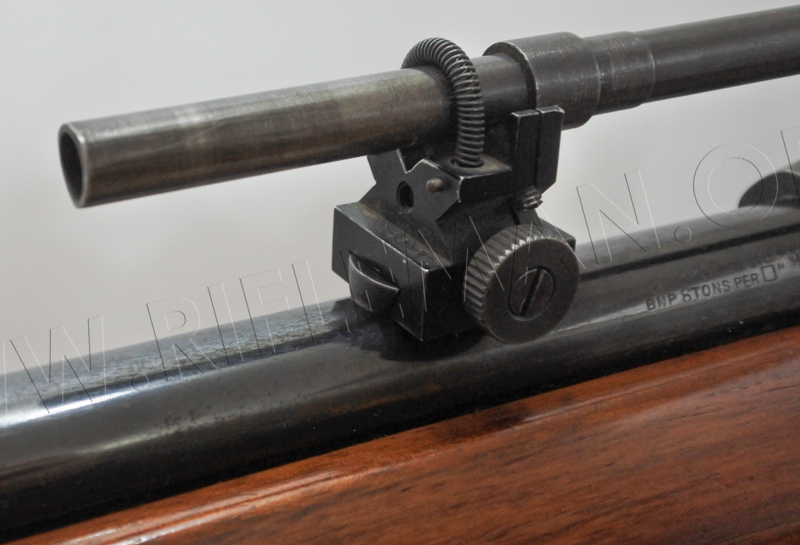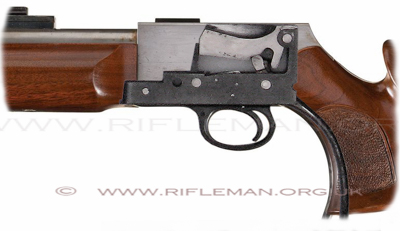The introduction of the BSA Martini International was heralded by an article in the British National Small-bore Rifle Association's (N.S.R.A) monthly journal, The Rifleman, in March 1950.
A facsimile of the article is shown below.
THE RIFLEMAN
MARCH 1950
A New B.S.A. Match Rifle
THE MARTINI action has stood
the test of time for 70 years and, during this period, has undoubtedly proved itself to be one of the finest actions in the world for
building into precision target rifles.
In many quarters of the
globe, including the United States of America, this "
old-timer " in its original form is even today preferred by many front
rank small-bore riflemen.

The main protagonists of the Martini in Great Britain
are, as everyone knows, the Birmingham Small Arms Company, who consider this action, far from being obsolescent,
deserving of a yet greater prominence the world over. Accordingly, they have seen
fit, in response to many requests for improvement, to undertake the modernisation
of the .22 " Martini " match rifle as a whole. This work has been
carried out with the co-operation of both British and American small-bore rifle
experts.
The new model, which has been aptly christened the
" Martini-International," is undoubtedly a rifle of character, and
B.S.A. Designs staff have, in our opinion, achieved an outstanding success.
The first feature which strikes one
forcibly is the handsome stock and fore-end which give to the rifle an
air of being " custom built." In point of fact, we understand that the
woodwork incorporates the ideas of the well-known American small-bore
connoisseur, Mr. Al Freeland of Rock Island,
Illinois, who has co-operated closely with B.S.A. throughout the development.
The butt and fore-end have been specifically styled to
meet the demands of the most discriminating shooter. The butt, with its
comfortable cheek piece, has just the right depth of comb to suit both iron and
telescopic sights and the broad beaver-tail fore-end complete with an
adjustable handstop provides a perfect hold.
Apart from this great advance in stock design, major
modifications have been made to the action, and the new square type, straight line body is, in itself, a thing of beauty.
Probably the most outstanding feature is that the action has been equipped with
a Power Ejector. A mechanism has been incorporated to ensure positive
extraction no matter how slowly the cocking lever is operated. The extractor,
loaded by a strong spring reflex, will, when released, throw the fired case
clear of the action. After firing a round, minimum pressure on the cocking
lever allows the breech block to fall and as soon as it is clear of the chamber,
the spring loaded extractor is released by a cleverly arranged secondary sear
which immediately ejects the case rearwards, the loading platform groove
deflecting it in an angular direction to the rear.
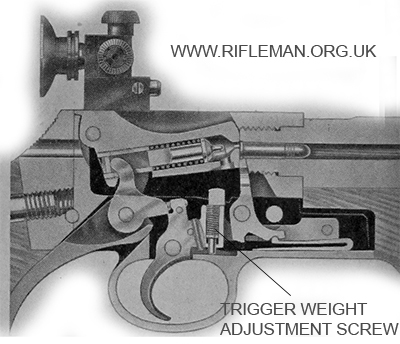
The trigger mechanism is an item of major interest as
it is not merely adjustable for weight of pull and sear engagement but it also
has a regulating screw to eliminate backlash. The trigger itself is broad and
grooved for maximum finger control, and is supported by an axis pin of generous
proportions, common in dimensions to those which support the breech block, cocking lever, tumbler and extractor. All adjustments
can be made with Allen type keys, which are supplied with the rifle. The heavy
barrel has a bullet lead designed to ensure that when the cartridge is fully
seated the bullet will be engraved by the rifling. The face of the breech block
is cam grooved so that after the cartridge has been inserted by hand the block
will, on rising, lever the round fully home as it reaches the closed position.
Boring and rifling characteristics have been modified
following exhaustive tests which have been conducted, with the most modern
types of ammunition currently manufactured in the United States, and under
these conditions the new " Martini-International" barrel has, the
manufacturers claim, consistently produced 1.25in. groups in or cutting, at 100 yards.
For those not requiring a heavy rifle a standard
weight barrel with plain woodwork is planned. Apart from these two variations
the rifle will be similar in every respect to the "
Martini-International" but will be known as the "
Martini-International " (Light Pattern).
The back
of the body is radiused and chequered to provide a
comfortable thumb rest, and the full pistol grip is of the close-up type; the grip, incidentally, has a " palm
swell " on the right-hand side to give additional comfort. The large
knurled knob located on the right-hand side of the body enables the action to
be removed from the body in an extremely simple fashion.
Messrs. Parker-Hale Limited are to be congratulated on having manufactured special
sights for this rifle, of extremely solid design. The tunnel foresight has an
anti-glare flange. A further feature of this latest addition to the Parker-Hale
range is that it is adjustable longitudinally for eye relief, which will be a boon to many shooters. The sight-line is common to both iron and
telescopic sights thus eliminating the necessity of stock alteration when using
the latter. Standard U.S. dovetail 'scope blocks will be fitted on every rifle.
For the interest of our readers,
we are tabulating below general technical data in regard to this interesting
new Match rifle which we feel will be universally sought after directly it
becomes available ; in this respect we are informed
that initial production will be entirely for export, and for the time being B.S.A. cannot accept orders for the Home Trade.
GENERAL DATA
Overall length : . . . . . . . . 44.2in.
Barrel length : . . . . . . . . . 28in.,
tapering from 1.12in. at breech to - .875in. at muzzle
Rifling : . . . . . . . . . . Six
grooves twist 1 in 16
Bore tolerance : . . . . . . . . .0005in.
Weight of the rifle : . . . . . . . . Approximately 14 lbs.
Stock : centre of trigger to butt plate . . . . 13.75in.
Drop
at comb
from line of standard sights zeroed for 25yds. . 1.6in.
Butt plate : . . . . . . . 1.94in. x 5.45in.
Fore-end : . . . . . . . Parallel
2..44in. wide, 16.37in.long.
. . . . . . . Handstop with 2.5in. of adjustment.
Sights : Sight base . . . . . . . Adjustable
from 29.0in to 31.4in.
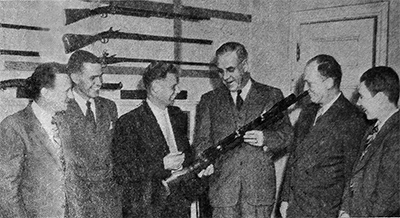
This picture was taken when Mr. A. J. Warwick, B.S.A. Sales Manager, called at the N.R.A. of American Headquarters and except for Mr. D. Waite,
includes the technical staff of the American Rifleman. Left to right they are : Edwards Brown, J. G. Rose, General Julian S. Hatcher (Technical Editor),
A. L. Barr, and the figure on the right, probably well known to our readers, is the Olympic 50 Metres Prone Rifle Champion, Arthur Cook.
Left to Right: Edward's Brown; J. G. Rose; A. J. Warwick; Gen. Julian S. Hatcher (A.H.); A.L. Barr; Arthur Cook
The introduction of the BSA Martini International was heralded by an article in the British National Small-bore Rifle Association's (N.S.R.A) monthly journal, The Rifleman, in March 1950.
A facsimile of the article is shown below.
THE RIFLEMAN
MARCH 1950
A New B.S.A. Match Rifle
THE MARTINI action has stood the test of time for 70 years and, during this period, has undoubtedly proved itself to be one of the finest actions in the world for building into precision target rifles.
In many quarters of the
globe, including the United States of America, this "
old-timer " in its original form is even today preferred by many front
rank small-bore riflemen.

The main protagonists of the Martini in Great Britain are, as everyone knows, the Birmingham Small Arms Company, who consider this action, far from being obsolescent, deserving of a yet greater prominence the world over. Accordingly, they have seen fit, in response to many requests for improvement, to undertake the modernisation of the .22 " Martini " match rifle as a whole. This work has been carried out with the co-operation of both British and American small-bore rifle experts.
The new model, which has been aptly christened the " Martini-International," is undoubtedly a rifle of character, and B.S.A. Designs staff have, in our opinion, achieved an outstanding success.
The first feature which strikes one forcibly is the handsome stock and fore-end which give to the rifle an air of being " custom built." In point of fact, we understand that the woodwork incorporates the ideas of the well-known American small-bore connoisseur, Mr. Al Freeland of Rock Island, Illinois, who has co-operated closely with B.S.A. throughout the development.
The butt and fore-end have been specifically styled to meet the demands of the most discriminating shooter. The butt, with its comfortable cheek piece, has just the right depth of comb to suit both iron and telescopic sights and the broad beaver-tail fore-end complete with an adjustable handstop provides a perfect hold.
Apart from this great advance in stock design, major modifications have been made to the action, and the new square type, straight line body is, in itself, a thing of beauty. Probably the most outstanding feature is that the action has been equipped with a Power Ejector. A mechanism has been incorporated to ensure positive extraction no matter how slowly the cocking lever is operated. The extractor, loaded by a strong spring reflex, will, when released, throw the fired case clear of the action. After firing a round, minimum pressure on the cocking lever allows the breech block to fall and as soon as it is clear of the chamber, the spring loaded extractor is released by a cleverly arranged secondary sear which immediately ejects the case rearwards, the loading platform groove deflecting it in an angular direction to the rear.

The trigger mechanism is an item of major interest as it is not merely adjustable for weight of pull and sear engagement but it also has a regulating screw to eliminate backlash. The trigger itself is broad and grooved for maximum finger control, and is supported by an axis pin of generous proportions, common in dimensions to those which support the breech block, cocking lever, tumbler and extractor. All adjustments can be made with Allen type keys, which are supplied with the rifle. The heavy barrel has a bullet lead designed to ensure that when the cartridge is fully seated the bullet will be engraved by the rifling. The face of the breech block is cam grooved so that after the cartridge has been inserted by hand the block will, on rising, lever the round fully home as it reaches the closed position.
Boring and rifling characteristics have been modified following exhaustive tests which have been conducted, with the most modern types of ammunition currently manufactured in the United States, and under these conditions the new " Martini-International" barrel has, the manufacturers claim, consistently produced 1.25in. groups in or cutting, at 100 yards.
For those not requiring a heavy rifle a standard weight barrel with plain woodwork is planned. Apart from these two variations the rifle will be similar in every respect to the " Martini-International" but will be known as the " Martini-International " (Light Pattern).
The back of the body is radiused and chequered to provide a comfortable thumb rest, and the full pistol grip is of the close-up type; the grip, incidentally, has a " palm swell " on the right-hand side to give additional comfort. The large knurled knob located on the right-hand side of the body enables the action to be removed from the body in an extremely simple fashion.
Messrs. Parker-Hale Limited are to be congratulated on having manufactured special sights for this rifle, of extremely solid design. The tunnel foresight has an anti-glare flange. A further feature of this latest addition to the Parker-Hale range is that it is adjustable longitudinally for eye relief, which will be a boon to many shooters. The sight-line is common to both iron and telescopic sights thus eliminating the necessity of stock alteration when using the latter. Standard U.S. dovetail 'scope blocks will be fitted on every rifle.
For the interest of our readers,
we are tabulating below general technical data in regard to this interesting
new Match rifle which we feel will be universally sought after directly it
becomes available ; in this respect we are informed
that initial production will be entirely for export, and for the time being B.S.A. cannot accept orders for the Home Trade.
Overall length : . . . . . . . . 44.2in.
Barrel length : . . . . . . . . . 28in.,
tapering from 1.12in. at breech to - .875in. at muzzle
Rifling : . . . . . . . . . . Six
grooves twist 1 in 16
Bore tolerance : . . . . . . . . .0005in.
Weight of the rifle : . . . . . . . . Approximately 14 lbs.
Stock : centre of trigger to butt plate . . . . 13.75in.
Drop
at comb
from line of standard sights zeroed for 25yds. . 1.6in.
Butt plate : . . . . . . . 1.94in. x 5.45in.
Fore-end : . . . . . . . Parallel
2..44in. wide, 16.37in.long.
. . . . . . . Handstop with 2.5in. of adjustment.
Sights : Sight base . . . . . . . Adjustable
from 29.0in to 31.4in.

This picture was taken when Mr. A. J. Warwick, B.S.A. Sales Manager, called at the N.R.A. of American Headquarters and except for Mr. D. Waite,
includes the technical staff of the American Rifleman. Left to right they are : Edwards Brown, J. G. Rose, General Julian S. Hatcher (Technical Editor),
A. L. Barr, and the figure on the right, probably well known to our readers, is the Olympic 50 Metres Prone Rifle Champion, Arthur Cook.
Left to Right: Edward's Brown; J. G. Rose; A. J. Warwick; Gen. Julian S. Hatcher (A.H.); A.L. Barr; Arthur Cook


Freeland's rifles were largely custom built in that clients could have the furniture cut to fit and the barrel weight of their choice, although the standard barrel was of the "bull" type in the terminology of the day, referring to its comparatively heavy weight in relation to the then norm for a small-bore target rifle.
The Freeland catalogue of ca. 1950 carried publicity on the back page
for what was effectively the preceding BSA Model 12/15 actioned rifle,
fitted with the early version of Freeland's stocking, and which shows a definite semblance
of what was to come with the first of the International BSA type rifles just shown above.
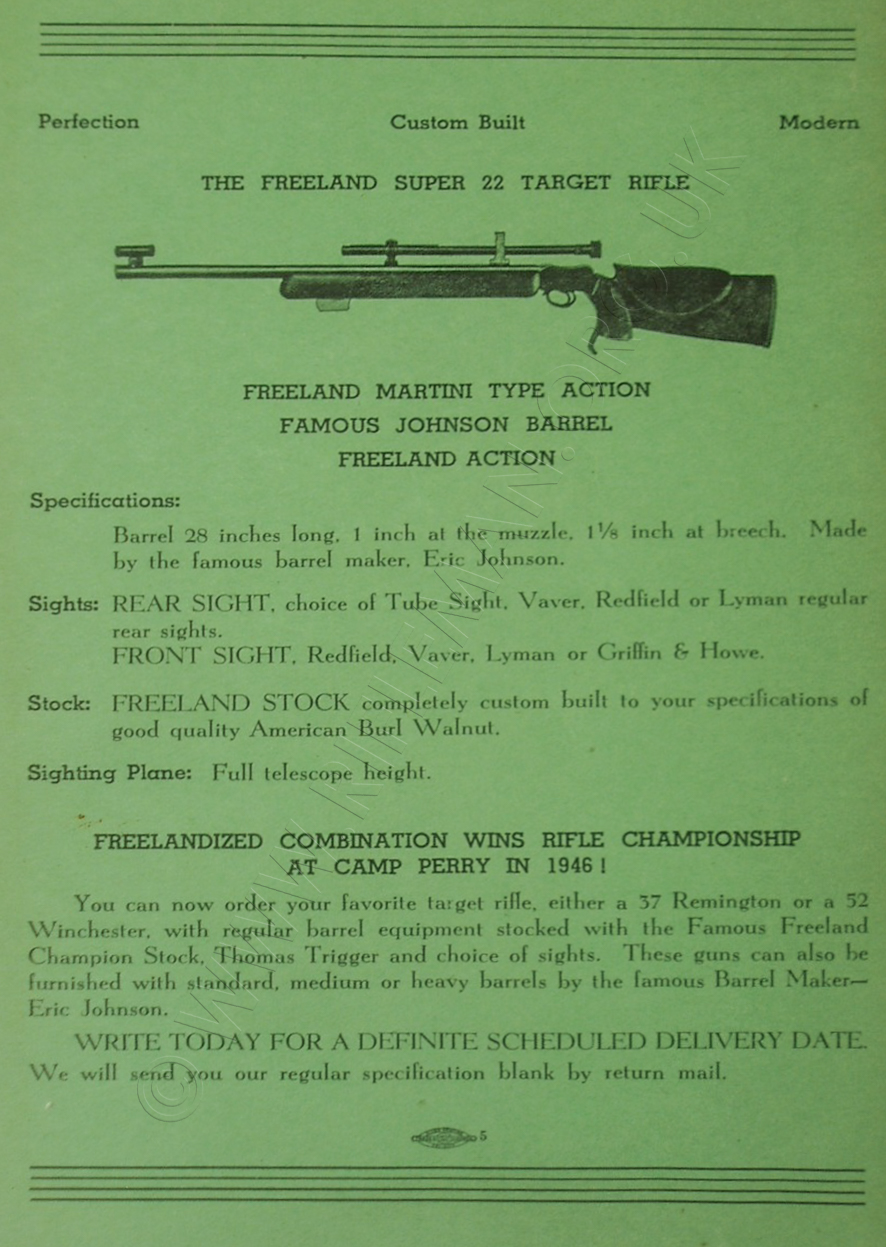
The rifle in the catalogue above was a furtherance of an earlier model of Freeland's rifles.
And here another contemporary 1950's advertisement for the first of the new rifle on Al Freeland's home territory.
The prices are more or less the same as those soon after asked for the Mark II in the U.S.A.
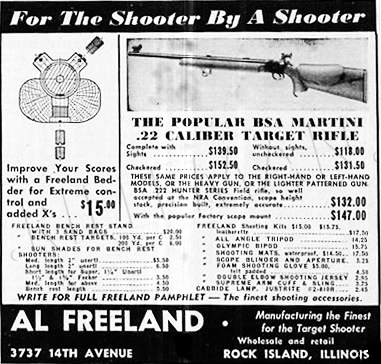
Freeland's 1957-58 catalogue offered not only the Mk.II rifle,
but afforded a thorough description of the components,
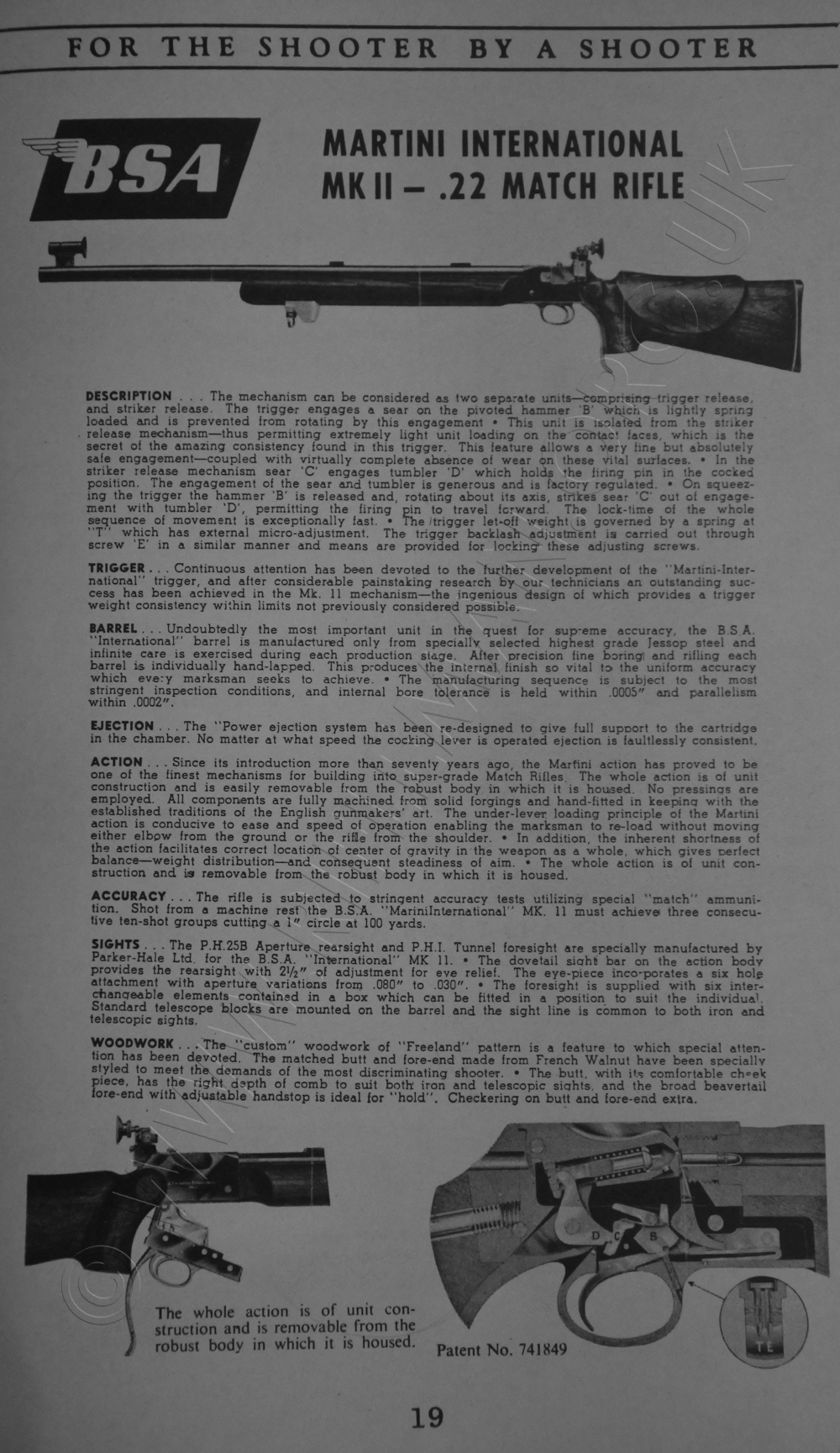
but included his specialist stocks, including a thumb-hole version,
with various configuration options for the rifle.
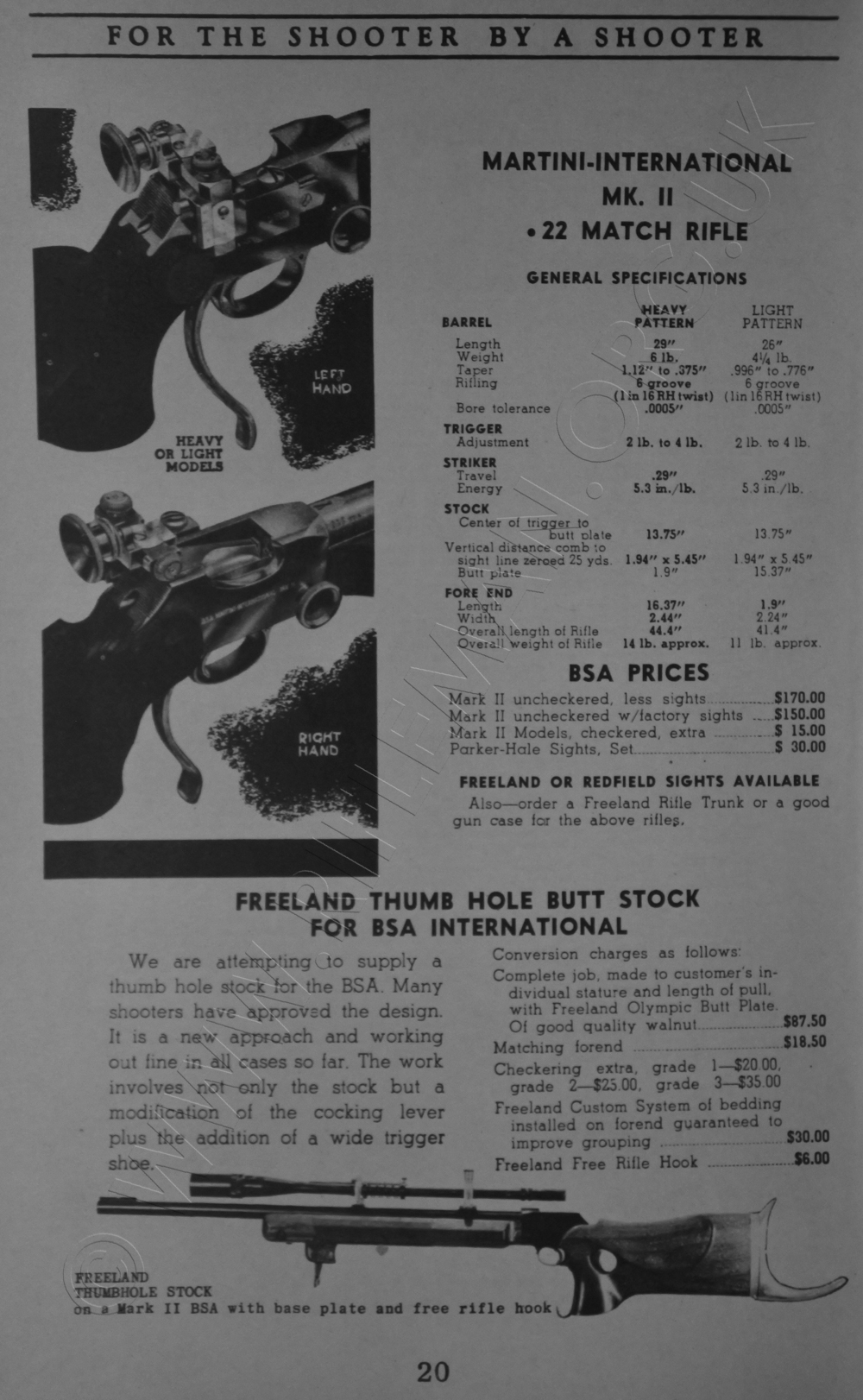
The complete and comprehensive FREELAND CATALOGUE FOR 1957-58 is available on site.
Marketed in the U.K. by Parker-Hale, and provided with their sights, the rifle first appeared for sale in their 1951-52 catalogue.
It was also shown in the catalogue for 1953 but, sadly for potential British customers, there was no price shown in the associated retailers' price list, and the relevant column bore the text "For Export Only"
beside the entries for both the standard heavy-barrelled model and the optional lighter weight version.

The BSA International ( latterly known as the Mark I ) RHS

whilst on the LHS, at the very rear lower corner, was lightly stamped
"MADE IN ENGLAND"
in lettering less than half the height of this representation.
Very modest!
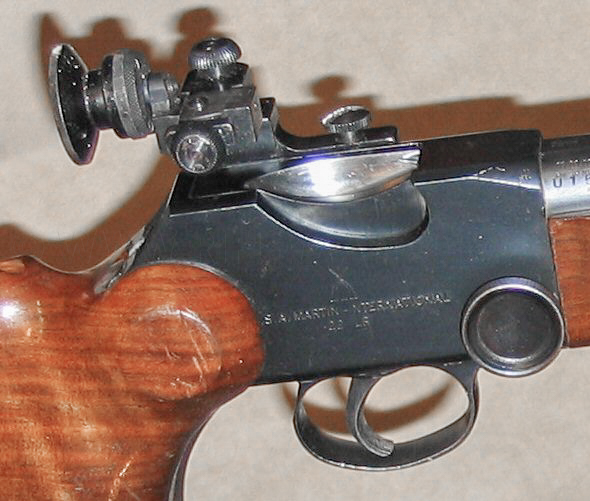
Below, the falling block and the extractor / ejector
lever can clearly be seen. The large slotted srew to the left side of the action
is the locking screw for the dovetail 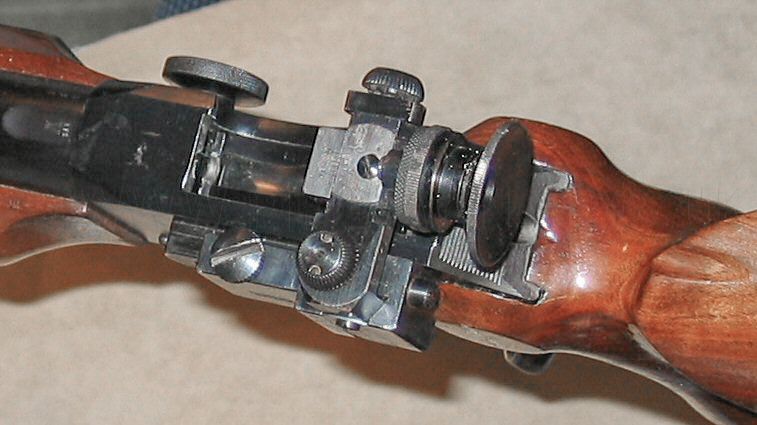 on which the Parker-Hale PH25 rear-sight mounts, permitting fore and aft adjustment. The original issue
PH25 sights were just 4 clicks to the minute adjustment. The later rifles were
fitted with PH 25A through E rear-sights with 8-click to the minute adjustment.
We have seen a PH25A sight fitted to a rifle with the serial number "U1578H", a heavy barrel model, believed exported to the States between 1951 and 1952. The serial numbers of the "Mark I" rifles were prefixed "U" and the heavy barrelled ones suffixed "H". The few left-hand models built in the second year of production were prefixed "UB". Many of the "Mark I" rifles were understandably retro-fitted, by their
owners, with the finer adjustment sights. The knurling on the rear of the action,
under the eyepiece, is a non-slip thumb contact area for the "thumb-up"
hand hold position. The groove just visible on the centre-line, below the knurling,
is the cut-out for the aperture through which a barrel cleaning rod can be passed.
The groove is continued back into the comb on the raised cheek-piece of the
butt-stock. The standard comb height was too high to otherwise permit a clear
run for the rod.
on which the Parker-Hale PH25 rear-sight mounts, permitting fore and aft adjustment. The original issue
PH25 sights were just 4 clicks to the minute adjustment. The later rifles were
fitted with PH 25A through E rear-sights with 8-click to the minute adjustment.
We have seen a PH25A sight fitted to a rifle with the serial number "U1578H", a heavy barrel model, believed exported to the States between 1951 and 1952. The serial numbers of the "Mark I" rifles were prefixed "U" and the heavy barrelled ones suffixed "H". The few left-hand models built in the second year of production were prefixed "UB". Many of the "Mark I" rifles were understandably retro-fitted, by their
owners, with the finer adjustment sights. The knurling on the rear of the action,
under the eyepiece, is a non-slip thumb contact area for the "thumb-up"
hand hold position. The groove just visible on the centre-line, below the knurling,
is the cut-out for the aperture through which a barrel cleaning rod can be passed.
The groove is continued back into the comb on the raised cheek-piece of the
butt-stock. The standard comb height was too high to otherwise permit a clear
run for the rod.
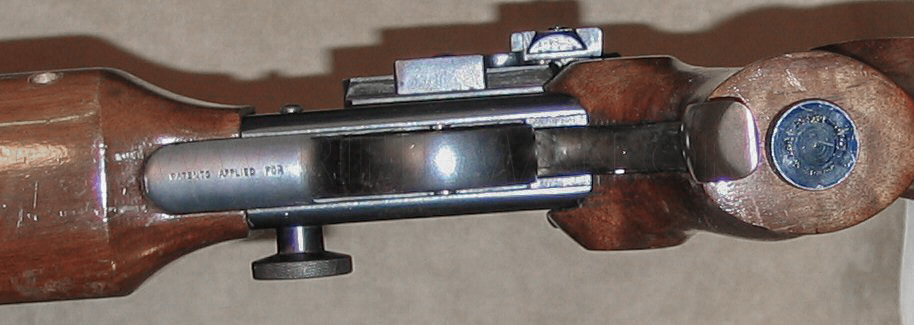 original production International, trigger
adjustment could only be achieved by removal of the action - a simple task
involving only the unscrewing of the action locking pin with its large diameter
knurled knob. However, whilst it is possible to access the three adjustment
screws without removal of the falling block ( a workshop job, since the extractor
lever bears back hard against the front of the falling block, with its considerable
leaf-spring pressure, and itself needs to be removed before the fulcrum for
the block can be driven out) one -drag adjustment - is accessed with a small
but long allen-key through a hole in the lower face of the extractor lever,
the second small and the third larger - vertically orientated - screws, respectively
the central and smaller of which is the backlash adjustment and the third
front screw bearing on the trigger's tensioning leaf spring for weight adjustment,
are less than a half inch under the falling block and require short cranked
original production International, trigger
adjustment could only be achieved by removal of the action - a simple task
involving only the unscrewing of the action locking pin with its large diameter
knurled knob. However, whilst it is possible to access the three adjustment
screws without removal of the falling block ( a workshop job, since the extractor
lever bears back hard against the front of the falling block, with its considerable
leaf-spring pressure, and itself needs to be removed before the fulcrum for
the block can be driven out) one -drag adjustment - is accessed with a small
but long allen-key through a hole in the lower face of the extractor lever,
the second small and the third larger - vertically orientated - screws, respectively
the central and smaller of which is the backlash adjustment and the third
front screw bearing on the trigger's tensioning leaf spring for weight adjustment,
are less than a half inch under the falling block and require short cranked  allen-keys. This design was not conducive
to quick adjustment on the range, and the modification, carried by the Mark
II rifle to put the weight and travel adjustment screws into the front of
the trigger-guard accessible externally from below, was also available as
a factory retro-fit for the owners of first production "Mark I"
rifles. This modification, and the addition of the designation "MK II"
in place of the original marking " .22 RF ", were the only
externally visible differences between the two Marks of standard rifle.
allen-keys. This design was not conducive
to quick adjustment on the range, and the modification, carried by the Mark
II rifle to put the weight and travel adjustment screws into the front of
the trigger-guard accessible externally from below, was also available as
a factory retro-fit for the owners of first production "Mark I"
rifles. This modification, and the addition of the designation "MK II"
in place of the original marking " .22 RF ", were the only
externally visible differences between the two Marks of standard rifle.
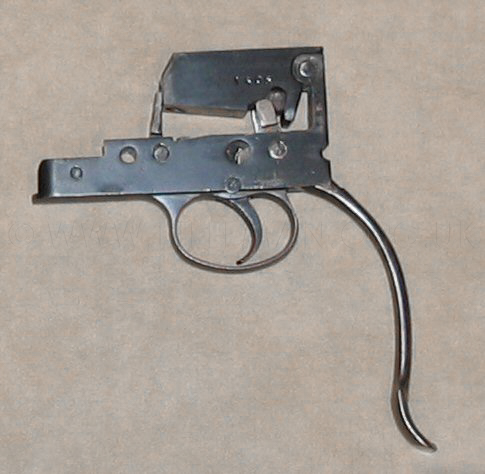
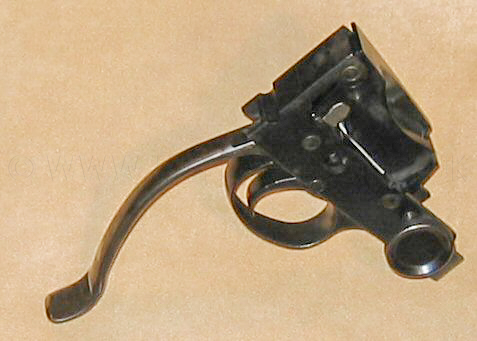
Below: the disassembled MK.1 action - an early example; serial number U 193.
Top left is the cut-off chamber section of the barrel, showing the threaded breech-end that screws into the receiver.
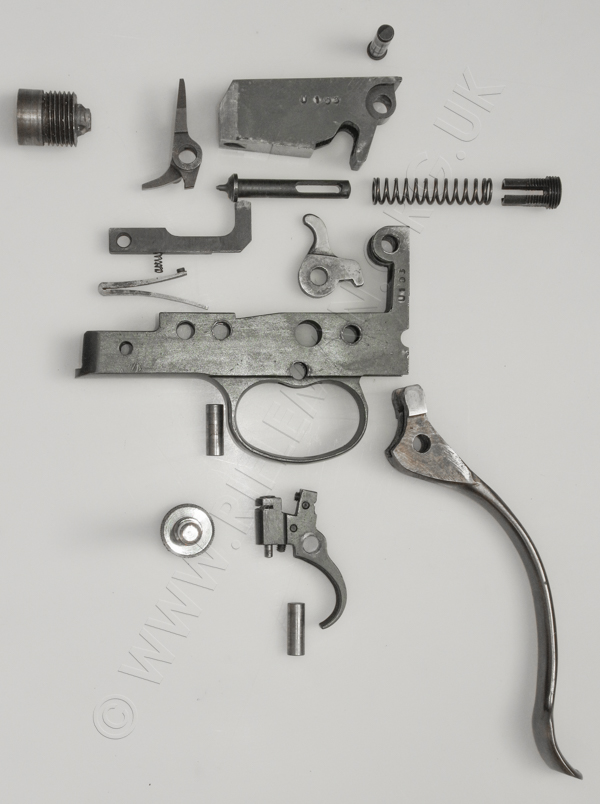
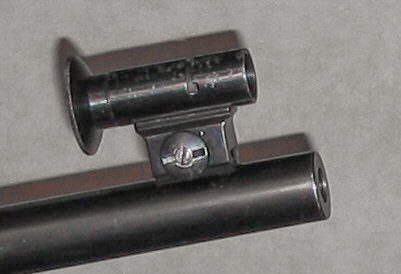
Below is a facsimile of the advertisement published in the 1951-52 Parker-Hale catalogue
after the introduction of the original International, and further down this page is a second set for the later Mark II.
We are fortunate to be able to show a particularly interesting early International.
This rifle is a "Mark I" that has received the modification of the adustable trigger.
It carries the very rare serial number prefix "X", and the number 1032.
This is one of a very few built up experimentally for the Eley Ammunition Company, to be used
to test the then new Tenex cartridge being manufactured as their premiere competition round.
The "Tenex" rifle in the 3D image below can be rotated through both axes by dragging your cursor left to right.
It can be zoomed and panned by clicking with the magnifier, and viewed full screen using the arrows top right.
The markings on the rifle are exactly as those of a standard Mark I, and the only updates, apart from the fine finish, are the adjustable trigger and the PH-25 B rear-sight still with just 4-clicks to the minute adjustment,
although improved to 8-clicks per minute on the following PH 25C model.
THE BSA MARTINI INTERNATIONAL Mk.II
The Mark II rifle in the 3D image below can be rotated through both axes by dragging your cursor left to right.
It can be zoomed and panned by clicking with the magnifier, and viewed full screen using the arrows top right.
BSA International Mk.II - Right side ............................................. and underside forward of the action, with the fore-end wood removed, showing trigger adjustment screws in the trigger guard
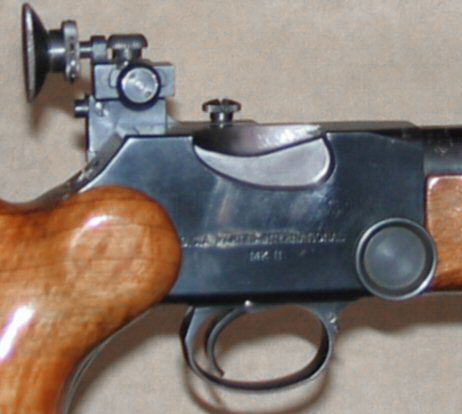 .............................
............................. 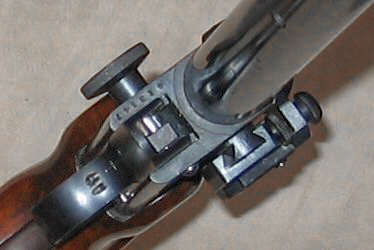


Below: the fore-end removed. It is held by only one screw into the underside of the barrel, thus transferring the sling load directly to the barrel. This was altered on the subsequent Mark III rifle, which was effectively a fully-floating barrel arrangement.
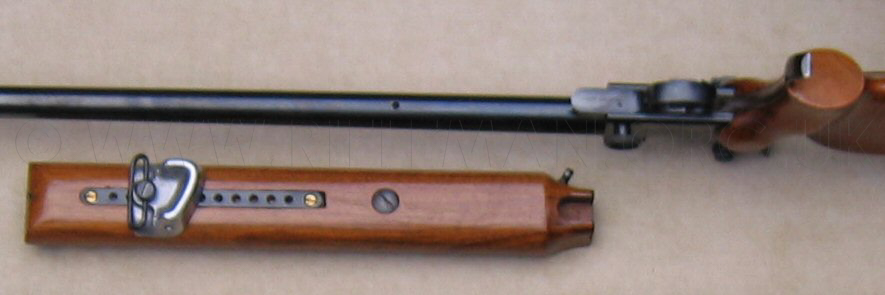
Below is a facsimile of the advertisement for the then "New" Mark II rifle, published in the 1953 Parker-Hale catalogue.
As already mentioned, the aperture rear-sight supplied with the early Internationals was the Parker-Hale Model 25.
The "Mark 1" had that sight, and the immediately following PH25A,
but the Mark II was graced with the updated PH25B, for which we show below the 1954 catalogue entry.
Below is the three-page centre-spread
/BSA_Int_MkII_3-fold_brochure.jpg)
The text on these three pages is as follows ............
"Produced by the Craftsmen of the Birmingham Small Arms Company Limited, England, the "Martini-International" Mk.II is the culminating achievement of almost a century of experience in the manufacture of High Grade Small Arms. Continued requests for improvements to meet the ever-present world demand for super accurate precision weapons have again encouraged B.S.A. designers to produce what we believe to be the finest match Rifle yet offered to satisfy the exacting requirements of the smallbore marksman.
"Continuous attention has been devoted to the further development of the "Martini-International" trigger, and after considerable painstaking research by our technicians an outstanding success has been achieved in the Mk. II mechanism — the ingenious design of which provides a trigger weight consistency within limits not previously considered possible.
DESCRIPTION
The mechanism can be considered as two separate units
-- comprising trigger release and striker release.
The trigger engages a sear on the pivoted hammer 'B' which is lightly spring
loaded and is prevented from rotating by this engagement. This unit is isolated
from the striker release mechanism — thus permitting extremely light unit
loading on the contact faces, which is the secret of the amazing consistency
found in this trigger. This feature allows a very fine but absolutely safe engagement
— coupled with virtually complete absence of wear on these vital surfaces.
In the striker release mechanism sear 'C' engages tumbler 'D' which holds the
firing pin in the cocked position. The engagement of the sear and tumbler is
generous and is factory regulated. On squeezing the trigger the hammer 'B' is
released and, rotating about its axis, strikes sear 'C' out of engagement with
tumbler 'D', permitting the firing pin to travel forward. The lock-time of the
whole sequence of movement is exceptionally fast. The trigger let-off weight
is governed by a spring at 'T' which has external micro-adjustment. The trigger
backlash adjustment is carried out through screw 'E' in a simiiar manner and
means are provided for locking these adjusting screws.
RIGHT-HAND • LEFT-HAND
HEAVY & LIGHT MODELS
Designed in close co-operation with small-bore experts on both sides of the Atlantic the B.S.A. "Martini-International" Mk. II provides the complete comfort necessary for improved scores, for both:- right-hand and left-hand marksmen — an exclusive feature not available on contemporary Match Rifles."
We have tried below to separately approximately replicate the last page of the brochure with its lengthy prose.
![]()
/BSA_Int_MkII_brochure-4.jpg)
Since its introduction - more: than seventy years ago, the Martini action has
proved to be one of the finest mechanisms forbuilding into super-grade Match
Rifles.
The whole action is of unit construction and is easily removable from the robust
body in which it is housed.
No pressings are employed. All components are fully machined from solid forgings
and hand-fitted in keeping with the established traditions of the English gunmakers'
art.
The under-lever loading principle of the Martini action is conducive to ease
and speed of operation enabling the marksman to re-load without moving
either elbow from the ground or the rifle from the shoulder.
In addition, the inherent shortness of the action facilitates correct location
of centre of gravity in the weapon as a whole, which gives perfect balance -
weight distribution - and consequent steadiness of aim.
The whole action is of unit construction and is removable from the robust body
in which it is housed.
 The
"Power" ejection system has been re-designed to give full support
to the cartridge in the chamber. No matter at what speed the cocking lever is
operated ejection is faultlessly consistent.
The
"Power" ejection system has been re-designed to give full support
to the cartridge in the chamber. No matter at what speed the cocking lever is
operated ejection is faultlessly consistent.
 Undoubtedly the most important unit in the quest for supreme accuracy, the B.S.A. "International" barrel is manufactured only from specially selected highest grade Jessop steel
and infinite care is exercised during each production stage.
Undoubtedly the most important unit in the quest for supreme accuracy, the B.S.A. "International" barrel is manufactured only from specially selected highest grade Jessop steel
and infinite care is exercised during each production stage.
After precision fine boring and rifling each barrel is individually hand-lapped.
This produces the internal finish so vital to the uniform accuracy which every
marksman seeks to achieve.
The Manufacturing sequence is subject to the most stringent inspection conditions,
and internal bore tolerance is held within .0005" and parallelism within
.0002".
![]() The rifle is subjected to stringent accuracy tests utilizing special "match"
ammunition. Shot from a machine rest the B'S.A. "Martini-International"
Mk II must achieve three consecutive ten-shot groups cutting a 1" circle
at 100 yards.
The rifle is subjected to stringent accuracy tests utilizing special "match"
ammunition. Shot from a machine rest the B'S.A. "Martini-International"
Mk II must achieve three consecutive ten-shot groups cutting a 1" circle
at 100 yards.
 The P.H.25B. Aperture rearsight and P.H.1 Tunnel foresight are specially manufactured
by Parker-Hale Ltd. for the B.S.A. "International" Mk II.
The P.H.25B. Aperture rearsight and P.H.1 Tunnel foresight are specially manufactured
by Parker-Hale Ltd. for the B.S.A. "International" Mk II.
The dovetail sight bar on the action body provides the rearsight with 2r of
tor for eye relief. The eye piece incor porates a six hole 
attachment wail aperture variations from .080 to .030".
The foresight is supplied with six interchangeable elements contained in a box
which can be fitted in a position to suit the individual. Standard telescope
blocks are mounted on the barrel and the sight line it common to both iron and
telescopic sights.
![]() The "custom" woodwork of "Freeland" pattern is a feature
to
The "custom" woodwork of "Freeland" pattern is a feature
to
which special attention has been devoted. The matched butt and
fore-end made from French Walnut have been specially styled to meet the demands
of the most discriminating shooter.
The butt, with its comfortable cheek piece, has the right depth of comb to suit both iron and telescopic sights, and the broad beavertail fore-end with adjustable handstop is ideal for "hold". Checkering* on butt and fore-end extra.
* In the U.K., this would be spelt as "chequering", which indicates the hoped for main market for the brochure, if not the rifle.
A fine copy of the U.K. pamphlet is shown below as a flip-book PDF file.
The text is searchable. Click the expansion square for full-screen viewing.
This may take a few moments to show
THE CARE & MAINTENANCE LEAFLET
for the BSA Martini International MK.II Match Rifle
Note that this document contains details of adjusting the trigger weight and creep of both the Mk.II and MK.III rifles, which are the same for any Mk.I rifle that has been retrofitted with the two small adjustment allen screws in the trigger-guard.
N.B. - Too light an adjustment of let-off trigger weight will risk premature firing, especially if the breech is closed firmly. Some shooters used to risk light trigger pressure settings in the knowledge that the rifle would not fire prematurely if the breech was closed very carefully; a frankly dangerous means of achieving this.
This can be viewed as a text-searchable flip-page document
or with vertical scrolling by clicking the portrait icon.
Depending upon the number of pages it may take a few moments to load.
Double tap tablet or click ![]() for full page display.
for full page display.
The schematic diagram below carried the part numbers and listing.
Hover over or Click image to bring up hi-res file and magnifier
Supplied with each new rifle, in addition to the above maintenance pamphlet .
was this folding card relating to the Parker-Hale sights supplied as standard.
The later Mk.III rifle had an improved Model 25 rearsight with one-eighth minute clicks
instead of the one-quarter minute clicks of the Mk.I and Mk.II rifles' sights shown on this page.
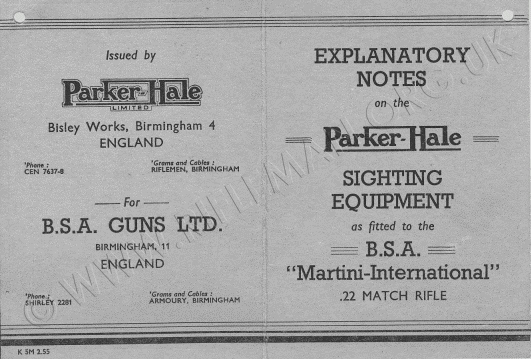
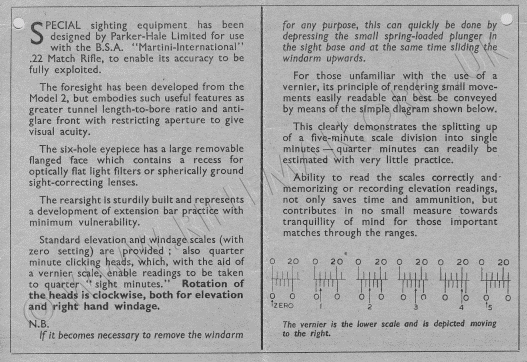
Below is an exploded view of the Mk.II rifle (click to view in greater detail),
and below that the official sectioned drawing with parts identification
Below, the drawing of the Mk.II International as illustrated in the contemporary BSA Spare Parts List
Click on the image to view the original sized drawing
and the associated key tables showing the parts and their contemporary pricing in Pounds Sterling
(with prices in shillings and pence, as prior to 1971 decimalisation).


We are able to show a pair of images of the rifles being tested on the company's range in the factory.
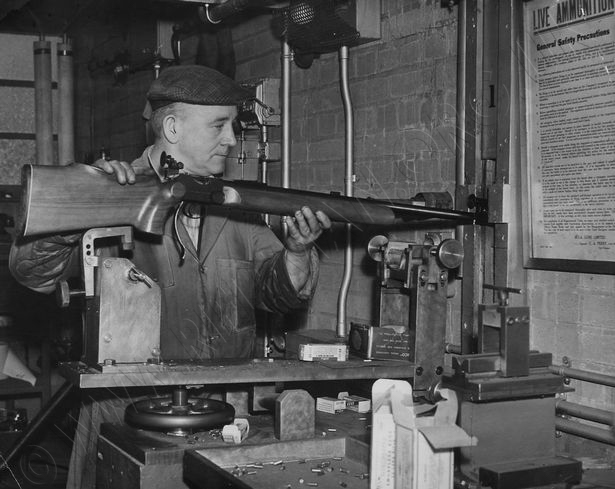 .
. 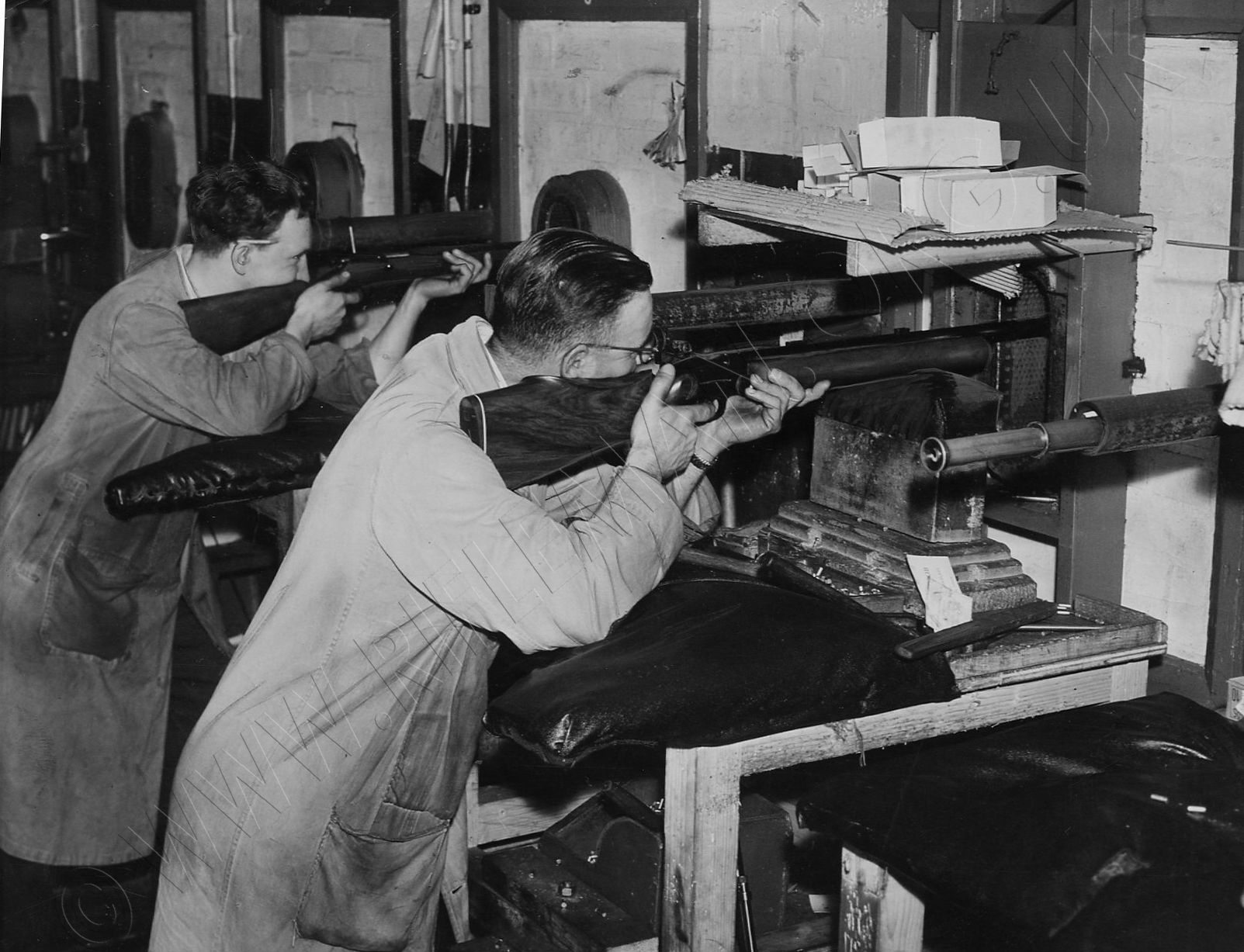
Several specialist sight systems were produced for the BSA Martini International rifles,
one of which was the "KR" in three marks.
Below are the details advertised for the KR Mk.III model suitable for both the Internationals Mk.II and III.
---------
`KR' MARK 111 TUBE-SIGHT
"Spring loaded vertically and horizontally with 1/8th minute clicks on 1/2 inch diameter knurled wheels.
Tube of best quality steel with anti-glare internal thread.
The front fits directly onto the rear telescope block on top of the barrel and is held in position by one screw.
The rear end of the tube is held between three spring-loaded rollers inside a bronze casting. This substantial casting is fixed directly to the side of the mechanism in place of the present sight holding bar, using the same two fixing screws. The main body of this casting is behind the breech block giving support just where it is needed and bringing the adjusting wheels nicely within the reach of the right hand. Takes the standard 6 hole or Iris eyepiece, which is not supplied with the tube-sight. Finished in gun-black throughout, this sight fits B.S.A. Mk. II and Mk. III International rifles. (Right hand only at present.)
Price, including plywood box £6 5s. plus 1/3d postage. Obtainable from the N.S.R.A. "We are able to illustrate both the Long and Short models of the Mk.III model.
The Short model is fitted to a Mk.II rifle,
the front mount using a telescopic sight dovetail block affixed to the front of the action body.
The rear mount uses the original fixings for the Parker-Hale PH25 rear-sight.
And the Long model below is fitted to a much later ISU rifle.
The Long model's mount carries a large letter "L" above the "KR" MARK III stamping.
The front mount uses the standard rear telescopic sight dovetail block.
The box for the Long Mk.III sight carries the makers company name and address.
K. R. GLASS Co., ADDINGTON STREET, RAMSGATE, KENT
Another tube sight was manufactured by the designer of the Kelly orthoptic headband for holding a lens and variable aperture iris in front of the shooter's eye.
Kelly's "Minitube" sight was advertised in the NSRA journal "The Rifleman". Models were available both for the BSA International and the Anschutz then Model 54 Match rifles.
The Anschutz version required the action to be drilled and tapped, a service offered by the Kelly company, but the BSA version was a simpler fit, as it came already attached to a PH25 rear-sight.
That shown in the advertisement was either for a left-handed rifle,
or the image was reversed in printing.
A kind reader has contributed an image of the Minitube for the Anschutz. It is ostensibly the same as that for the International, but with a different mounting bracket.
..
The Minitube employed a much narrower sighting tube, such as later became more popular.
The point is perhaps illustrated by an unidentified tube sight here fitted for convenience to the I.S.U. rifle.
Again, the front mount fits to the rear telescope dovetail block.
The unit is professionally made, and uses a spring to hold the front of the tube in position in a groove in the block. There is a sleeve around the tube to keep the tube in place fore and aft.
The unit is neatly fitted into a well-made plwood box.
The rear of the tube simply screws back into the normal eye-piece holder of the PH25 sight's windage arm,
and allows for fitment of any standard eye-piece or adjustable iris.
A close-up of the front mount.
Should you know anything of this tube sight please do let us know.
_______________
One interesting modified Mark II rifle came to our notice a while ago. Probably engineered after the introduction of the International Mark III, and in an attempt to emulate that rifle's free-floating barrel configuration, an enterprising owner took the significant step of upgrading his Mark II with an inventive outer sleeve arrangement for the barrel to support the fore-end woodwork, from close to the receiver, and clear of the major part of the barrel. Two bolts passed through the fore-end into threaded lugs on the sleeve. These are not bedding bolts, but only fasten the fore-end to the barrel's new outer sleeve.
/BSA_Int_MkII_free-floating_mod-1.jpg) ..........
.......... /BSA_Int_MkII_free-floating_mod-2.jpg)
Quite apart from such as the modified rifle above, and the ongoing popular and long-term use
of standard form rifles in historic competition,
it can be seen below that a Martini International Mk.II's day is never done!
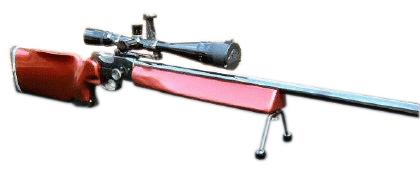
The above rifle has been especially modified for benchrest use
Or see the "bull-barrelled" Mk.V shown at the bottom of the page for the Internationals Mks. IV &V.
We also have a page about the conversion of rifles for benchrest competition,
including the BSA International HERE
See also the BSA Martini International Mk.III
The history of the Martini International has a continuing North American aspect, illustrated by the sale in 2019 of one of Al Freeland's prototypes by the well known Rock Island auction house.

Their description written up for the rifle's sale read as follows, and affords an additional potted history of Al Freeland's involvement with the Birmingham Small Arms Company and the bringing into production of the International rifles:-

Images by courtesy of the Rock Island Auction Company
This is a super rare and very historic BSA Martini Prototype single shot rifle. This one of a kind rifle was purchased directly from the Freeland family estate after Al had passed away and the gun shop was closed. In looking at the rifle we believe it to be the "Prototype" for the "Mark Series" Martini rifles as manufactured by the BSA Company based on the recommendations from Al Freeland. Al Freeland produced this design in his gun shop by adopting a MK I trigger group/bolt assembly to his newly designed receiver. The receiver actually has no markings and is slightly longer than the MK I, however the trigger group/bolt assembly is stamped "UF734" on side. At that time he designed it to use two action locking screws, one mounted on each side, later this was changed to using just one large through bolt screw to secure the trigger assembly inside the receiver. It still retains the larger ejection port on the right side and it now incorporates a step on the back side of the receiver to keep the buttstock from shifting sideways, which was eventually incorporated into all later BSA Martini designs. During the assembly Al fitted a super rare Eric Johnson "8 Star" target barrel. This is the only "8 Star" Eric Johnson barrel this describer has even seen. Certainly this designates this barrel as the best/highest quality barrel produced by Mr. Johnson, who in his own right was one of the premier target rifles makers in the 1940-1960s.The top of the barrel is stamped: "MADE BY ERIC JOHNSON/*****8" and towards the breech it is marked "FOR 22 L.R. ONLY". Al Freeland then fitted one of his custom long forends with the double screws on the bottom with a hand stop rail. He also fitted one of his custom three position buttstocks, both of these became the standard signature patterns for all follow-on BSA Martini Target rifles. The buttstock is also fitted with one of Freeland's adjustable aluminum buttplates with the black sure-grip buttplate pads. As noted the action is unmarked and both the receiver and barrel are in the white. This rifle also comes with its original black fiberboard Freeland rifle case. This was the traditional target rifle carrying case used by hundreds of target shooter in the 1950s through the 1980s, that was designed and sold by Freelands gun shop.
Class: Modern Long Gun
Very fine with the receiver and barrel all completely in the white as noted above. The internal trigger grip and bolt are blued/in the white as supplied by the factory. The walnut stock and forend are both in very fine condition with 85% + of their original varnish showing minor handling marks and finish loss on the sides. The carrying case is in good condition with the hinges, protective corners and Freeland name plate intact, but showing staining along the lower sides of the case. A very rare and historic BSA Martini Prototype single shot rifle.
The serial number UF 734 of the action relates to a BSA standard International Mark II rifle. 3,390 rifles of the MK.II series were manufactured between 1953 and 1961, when the Mk.III was introduced, putting this action approximately one third of the way through that period. Not a perfect means of assessing dates, as annual production may have been greater in the earlier years, but an estimated date range between 1961 and 1962 would not be unreasonable, particularly because the development of the Mark III rifle was underway at B.S.A. well before 1961, with five prototypes being built for trials.
Serial No.2 of these rifles was used in the 1964 Tokyo Olympics by John Hall, who worked at Eley.
The comment in the write-up that the receiver is longer than the Mark 1 is therefore interesting but, as no dimensions are given, it is not easy to confirm by how much. It does not though appear to be as far extended as the following Mark III receiver.
We have overlain the action and receiver of a Mk.II rifle onto that of the prototype to the same scale. The forward extension of the receiver then becomes apparent.
It can be seen that, although the underlever's curvature has been reshaped to fit the different shape of pistol-grip, its pivot point is the same. Scaling from the trigger pivot pin to the front of the receiver, which on the Mk.II rifle is 2.20 inches, the prototype's receiver has been extended by ???? inches. The same measurement on a Mk. III rifle is 4.30 inches, and on the prototype Mk. III used by John Hall in the 1964 Olympics this measurement is 3.70 inches.
From the Mk.II scaled dimensions, the Freeland prototype action is approximately 0.58 inches longer (14-15mm).
Below: a table that affords comparison between the various marks of International rifle.
| RIFLE | TRIGGER PIN to FRONT of ACTION inches | TOP of ACTION to REAR BEVEL inches | NOTE |
|---|---|---|---|
| Mark I | 2.065 |
3.800 |
trigger pin concealed |
| Mark II | 2.200 |
3.725 |
|
| Freeland Prototype | 2.780 |
4.305 |
Estimated from images |
| Prototype Mk.III | 3.700 |
5.185 |
|
| Production Mk.III | 4.300 |
5.950 |
|
| I.S.U. | 3.25 |
4.85 |
as Mks. IV and V |
An additional point is that, while the two actions appear of identical height, the top of the Johnson barrel is slightly lower than that of the Mk.II. This could be related to the height of the centre of the bore, or to the barrel diameters varying, or perhaps even a combination of the two. With no dimensions available it is difficult to judge.
It could certainly be argued that this prototype rifle is a half-way house between the models Mark II and III. It would be interesting to know more of precisely how the barrel is bedded with the fore-end, but the furniture is described as still having the two bedding screws at the bottom, suggesting that the configuration is still to that of the Mark II rather than the free-floating arrangement of the Mark III.
In his 1955 book "Rifleman and Pistolman", L.B. Escrit wrote a chapter
about "Buying a .22 Rifle".
It gives an insight into the manner of thought behind what was then available,
and what was to be best recommended. He specifically mentions both the BSA Martini International and its predecessor the BSA Model 12/15.
There are two excellent sectional drawings of of the Mk.II International.
This can be viewed as a text-searchable flip-page document
or with vertical scrolling by clicking the portrait icon.
It may take a few moments to load.
Double tap tablet or click ![]() for full page display.
for full page display.
See also the BSA Martini International Mk.III


